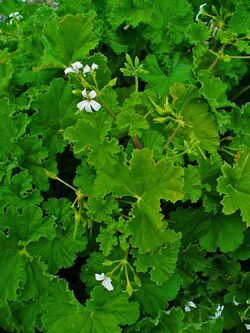Biology:Pelargonium odoratissimum
| Pelargonium odoratissimum | |
|---|---|

| |
| Scientific classification | |
| Kingdom: | Plantae |
| Clade: | Tracheophytes |
| Clade: | Angiosperms |
| Clade: | Eudicots |
| Clade: | Rosids |
| Order: | Geraniales |
| Family: | Geraniaceae |
| Genus: | Pelargonium |
| Subgenus: | Pelargonium subg. Reniformia |
| Species: | P. odoratissimum
|
| Binomial name | |
| Pelargonium odoratissimum (L.) L'Hér.
| |
Pelargonium odoratissimum is a pelargonium species native to South Africa .[1][2] It is also known as the apple geranium or apple pelargonium due to the distinct apple scent. It is in the subgenus Reniforme along with Pelargonium sidoides and Pelargonium exstipulatum.
Etymology
Pelargonium comes from the Greek; Pelargos which means stork. Another name for pelargoniums is storksbills due to the shape of their fruit. Odoratissimum refers to the highly scented leaves.
Description
Pelargonium odoratissimum is a small, spreading species which only grows up to 30 cm high and 60 cm wide. It has small pale pink flowers and its leaves are waxy, green and ovate.
Cultivars and hybrids
There are quite a few cultivars and hybrids of Pelargonium odoratissimum. These cultivars and hybrids include:
- Pelargonium odoratissimum 'Big Apple' - A variety with larger leaves and a "Granny Smith" apple scent.
- Pelargonium odoratissimum 'Fringed Apple' - A variety with a slight hint of mint as well as apple fragrance.
- Pelargonium × fragrans - A hybrid between P. odoratissimum and Pelargonium exstipulatum. It has spicy, eucalyptus scented leaves. A popular cultivar of this is P. 'Old Spice' which smells as the name suggests; of Old Spice.
- Pelargonium 'Lillan Pottinger' - An apple scented hybrid of P. odoratissimum and P. × fragrans .
Uses
As well as being a houseplant or outdoor perennial depending on climate, Pelargonium odoratissimum other uses. It is used for its astringent, tonic and antiseptic effects. It is used internally for debility, gastroenteritis, and hemorrhage and externally for skin complaints, injuries, and neuralgia and throat infections. The essential oil is used in aromatherapy and has a delicious apple aroma. It is also used to balance the hormonal system, menstrual flow, and clean the body of toxins.
In Cyprus the leaves are used to flavour cake and pastry syrups. It also sometimes preserved and eaten as a spoon sweet (glyko tou koutaliou).
References
- ↑ Khalid, Khalid A.; Teixeira da Silva, Jaime A.; Cai, Weiming (2010-06-03). "Water deficit and polyethylene glycol 6000 affects morphological and biochemical characters of Pelargonium odoratissimum (L.)" (in en). Scientia Horticulturae 125 (2): 159–166. doi:10.1016/j.scienta.2010.03.009. ISSN 0304-4238. https://www.sciencedirect.com/science/article/pii/S0304423810001214.
- ↑ Christodoulakis, Nikolaos S.; Gargeraki, Kalliope; Fasseas, Costas (2013-04-03). "Leaf Structure of Pelargonium odoratissimum (Soland.), an Aromatic Species Widely Used in Herbal Remedies and Confectionery". Journal of Herbs, Spices & Medicinal Plants 19 (2): 132–143. doi:10.1080/10496475.2012.755943. ISSN 1049-6475. https://doi.org/10.1080/10496475.2012.755943.
External links
Wikidata ☰ Q149880 entry
 |

